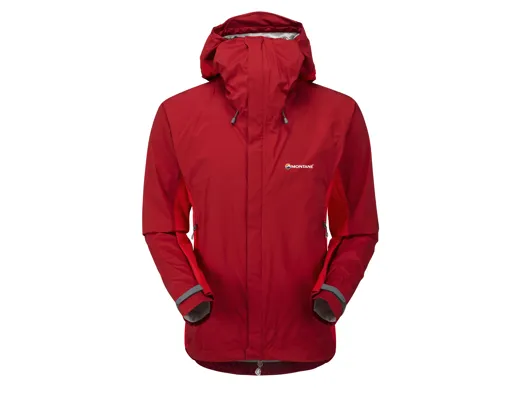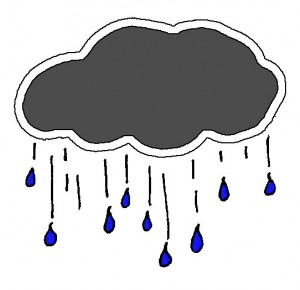My Montane Lakeland 100 t-shirt is probably my favourite top. In fact I like it so much I recently went out and bought another just like it (without the Lakeland logo of course). They are a great fit, they feel substantial enough for the winter and yet are cool enough for running in summer. What’s that got to do with waterproofs I hear you asking, well while I was buying the t-shirt I couldn’t resist picking up a Montane Atomic Jacket.

The week after making this purchase we were hit by some of the worst storms we’d had in decades, with widespread flooding across the region. What better opportunity to but my new jacket to the test. Heading over to the Lakes the roads started to look like rivers, the drains unable to clear the driving rain as quickly as it was falling. As I parked at Pooley Bridge I watched a group of walkers from the car in front make their way over the road and onto the fells, my the time i’d changed into my fell shoes and checked my bag, they were crossing back over the road having decided it was too wet for walking. I ran the 10 miles to just short of Mardale Head via Howtown and then back again. The rain stopped for a while as I made my way up from Howtown to the Roman Road, but by that time like my fell shoes my base layer was pretty wet.
Unsure as to whether it was the weather or simply sweat that had caused this dampness I contacted Montane via there facebook page to ask ‘how waterproof a water proof should be’. Montane’s customer service was quite excellent. They posted a response almost immediately offering to test the jacket for me. I replied saying that I was actually more interested in finding out about the tech specs than returning the jacket. The response was a fantastic post detailing water resistance and breathability across their jacket range.
Basically there are 4 things to look out for when buying a running water proof.
- Weight
- Size
- Hydrostatic Head
- Moisture Vapour Transmission Rate (MVTR).
Obviously weight makes a difference as you have to carry it, as does size, you need to get in in your pack (when your not running in it). Hydrostatic Head is basically how high a column of water you need before droplets of water start to seep through a sample of the fabric stretch across the bottom of a tube of 1 inch diameter left for 24 hours. The problem with this measures is it does not take into account factors like wind driving rain through the fabric, or the fabric rubbing against wet vegitation, your arms or pack. As a minimum european waterproofs have to have a Hydrostatic Head of 1500mm to resist light showers, but as activities just as kneeling can add up to 8000mm. So for use in active sports a fabric would have to be able to withstand at least 10,000mm to resist heavy rain and driving wind. [The Atomic has 10,000mm while the Minimus 20,000 and Classic GoreTex 28,000mm]
Moisture Vapour Transmission Rate is a measure of a fabrics breathability, or the amount of water vapour the fabric will allow out in 24 hours. The average person will produce between 0.5 and 1L of sweat during 30 minutes of moderate to heavy exercise, depending on a number of factors like how hot it is, whether there’s a breeze, how many layers the person is wearing, how fit they are etc. If you multiply this by 48 you get to between 24 and 48L which is the sort of Moisture Vapour Transmission Rate that would be needed to keep dry under these condition. The Moisture Vapour Transmission Rate therefore as important if not more so than the Hydrostatic Head. After all there’s not much use in stopping water getting in, if your already wet on the inside.
[The Atomic has a MVTR of 8000g, the Minimus 20,000g]
Moisture Vapour Transmission Rate is a measure of a fabrics breathability, or the amount of water vapour the fabric will allow out in 24 hours. The average person will produce between 0.5 and 1L of sweat during 30 minutes of moderate to heavy exercise, depending on a number of factors like how hot it is, whether there’s a breeze, how many layers the person is wearing, how fit they are etc. If you multiply this by 48 you get to between 24 and 48L which is the sort of Moisture Vapour Transmission Rate that would be needed to keep dry under these condition. The Moisture Vapour Transmission Rate therefore as important if not more so than the Hydrostatic Head. After all there’s not much use in stopping water getting in, if your already wet on the inside.
[The Atomic has a MVTR of 8000g, the Minimus 20,000g]
So it was probably the Moisture Vapour Transmission Rate of the Atomic at 8000g that caused me to get wet on my run and not the Hydrostatic Head at 10,000mm. It would seem that I may have been better of spending a little more and buying something like the Air at 20,000mm and 21,000g which is better suited to the requirements of running in these more extreme conditions.
Looking back I could have done a couple of things to ensure I stayed drier longer. Firstly I could have taken a base layer off when I put the water proof on. I was warm enough running without the jacket, so adding an additional layer just made me sweat more. I could have also tried to reduced the amount of pressure on the fabric by not brushing past vegetation as I ran or adjusting my back pack so the straps didn’t flap against the jacket.
Even by English summer standards we’ve seen some pretty extreme weather this year, which has been wet enough to put any waterproofs to the test…So if you like running in the rain but not necessarily getting soaked to the skin, then my advice would be…go for the highest MVTR rating you can afford when buying your next running waterproof .








Thanks for that David, really useful. I bought an OMM Kamleika jacket a couple of weeks ago, for the Lakeland 50, and I have yet to test it properly. Wish I had read your blog before I purchased, I would have been better informed.